Providing a meaningful experience to our user is the holy grail of any product. Many theories confront this challenge and try to explain how to reach a great experience or how our brain responds to one (see: Flow Theory, Fun Theory, and Multiple Intelligences, just to name a few). We believe that learning, educating or teaching - are no different than any commercial product, in their need to strive to provide a meaningful experience to their "clients", the students.
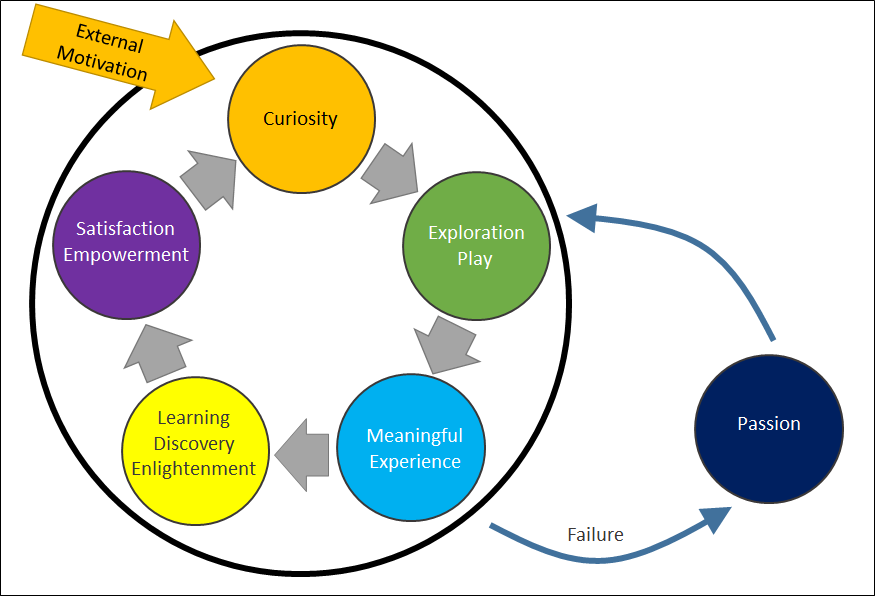
But there is still quite a distance between the theory and practice. Building on our experience from designing and developing video games, we believe we have found some math that can bridge that gap. When we connect that with what we know on psychology and learning theories, we came up with a new model that connects Learning, Passion, Curiosity and Meaningful Experience.
How can we inspire curiosity in students that do not necessarily want to be engaged? How do we keep nurturing it over time? We believe that by offering meaningful play you might be able to create meaningful experiences for the user, which would bring moments of enlightenment. This should trigger more curiosity and develop passionate learners.
This is a longer explanation of the learning model we developed, and work according to. We believe many other creative teachers and instructional designers would relate to this model.
Keep in mind this model is relying on previous research and learning theories, but has greatly evolved through hands-on practice. We will happily offer more examples, and would love to assist further academic research in this field.
Curiosity
Learning starts with curiosity. A huge research effort today is focused in discovering what triggers the curiosity of a person, so we could use it to engage them in an educational activity. Curiosity can rise from a certain media or medium or technology; or from dealing with a field of interest. The main point here, is that the user needs to care about it. As teachers and educators, if we wish to teach something to another person, we need to make sure they are intrigued or interested. We need to make sure they WANT to engage the process.
We should care about what interests our students, what gets to them, what might trigger them to action. In the user centered design we call this a user research... If we would make an app that no one would find interesting, this would be a waste of time and money. The same view should apply to lesson planning and instructional design. We shouldn't take for granted that the students sit in our classroom. We should make them WANT to be there.
We believe Gardner's theory of multiple intelligences [1] offers a thorough path to understanding others' minds and triggers. An advanced aspect of the user centered design, called Persuasive Design, aims to take advantage of social pressure and other design techniques, in order to make a user decides on the option we want them to [2]. These techniques can, and should, be used for good reasons.

[1] Gardner H. (1983). Frames of Mind: The Theory of Multiple Intelligences. Presus Books
[2] Nodder C. (2013). Evil by Design: Interaction Design to Lead us into Temptation. Indiana: Wiley.
Exploration and Play
Seymour Papert, the inventor of Constructionism, once said that "when we try to teach something, we deprive the learner from the joy of discovery". Meaning that learning should offer independent exploration into the subject matter. Scot Osterweil, the creative director of the MIT Educational Arcade and the founder of Learning Games Network, claimed that "we need less teaching and a more gentle guidance". Teachers should refrain from being a source of information, and rather see themselves as the director and instructor of how to reach information, while the student explores a certain subject.
Once a learner is curios, we should let them explore. Using play or playful approaches (or activities) user engages objects, content or software. There is a wide array of activities and selecting suitable ones depends on the content and the audience. As a general guideline, good activities for exploration phase are creative and open-ended. Ones that leave you with more questions and offer different ways of interactions and engagements.
Mitchel Resnick, MIT Professor for Learning, referred to this stage as the PLAY phase, in his Spiral of Creative Learning [3].
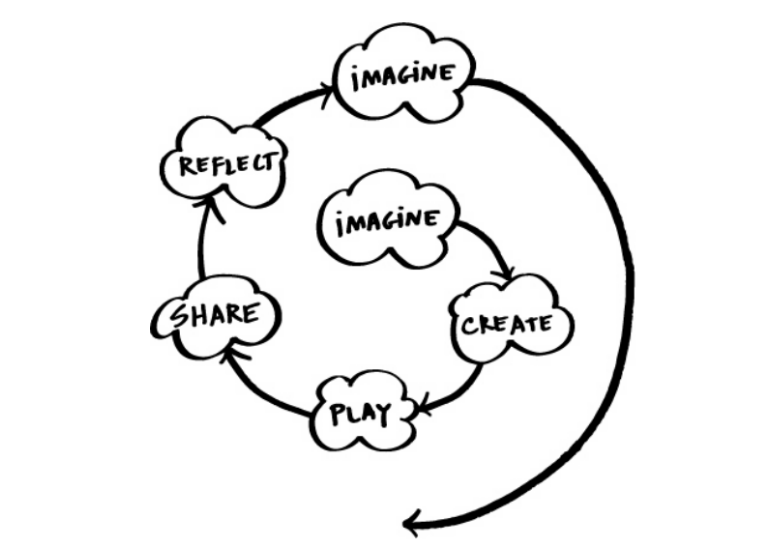
[3] Resnick M. (2007). All I Really Need to Know (About Creative Thinking) I Learned (By Studying How Children Learn) in Kindergarten. In Proceedings of 6th ACM SIGCHI conference on Creativity & Cognition. Washington USA.
Meaningful Experience
Meaningful experiences are the most powerful learning points. From the pain of touching a flame, to the way soil feels in our hands and mouth. We experience with all our senses, and the more senses being used, the bigger the experience would feel.
Experiences can be positive or negative, successful or disappointing, joyous or sad. To become meaningful, it should relate to us, appeal to our interests, emotions, needs or motives.
User centered design approach provides much insight to answering that question of how to make an interface appealing. Alan Cooper, inventor of Personas, once said that “technology should make us feel more awesome, and the product we use should make us super-human".
Facing a challenge is one way to offer a meaningful experience. Challenges make us think, confront issues, and come up with solutions. Much like in games.

"We experience with all our senses"
Learning, Satisfaction and Empowerment
If we succeed the challenge we faced, it means we had to learn something. Either about the subject matter or the medium. Example to the latter could be this: say we play a game that has a new interface or a new mechanic, we would need to spend some time just learning that mechanic. That would be a simple challenge. If we now need to use all our knowledge to beat a powerful monster - that's a bigger challenge.
Learning might come as a discovery of something you didn't know before. It can also take the form of an enlightenment or insight, a significant understanding of a key knowledge piece in the content. Several discoveries might lead to an enlightenment. Several insights will bring great satisfaction.
Satisfaction is the feeling of achievement and accomplishment. When conquering a challenge, one feels competent. We are empowered by that process of gaining new knowledge or skill. It feels as a breakthrough. We feel smarter, bigger and become stronger beings. Neil Gershenfeld, founder of the FabLab organization, captured that moment saying "there's a magical window just after you learn something, when you're dying to tell somebody". He urges teachers to leverage that moment, and let the student explain to the rest of the class what they have learned.
More knowledge gets us more curious about what else is out there and what else could be investigated. What other questions we can ask on the subject matter. That specific feeling is intrinsic curiosity. We are now driven by our new gained insights and skills and not by external motivations. Thus completing a cycle.

Discovery: to move the bicycles forward I need to push these thingies (pedals)
Insight: if I place the pedal on the upmost position, the first push will be strongest
Insight: if I start with a big push (by standing up), it will be easier to continue
Empowerment: I ride a bicycle for 10 meters with no one holding me!
Passion and Failure
Malone and Lepper researched what triggers a person to act and what could influence their behavior. They differentiated intrinsic motivations from extrinsic ones [4]. Intrinsic motivation is much more sustainable and strong, since the person acts based on intrinsic rewards. In our words, this is Passion. This is the power that will get you out of bed on time, because YOU want to be at a specific lesson, and not because you were told to or forced to. Passion could be developed for the subject matter ("I love physics"), for the interaction/experience ("I love sky-diving") or for a specific tech/medium ("I love puzzles").
We are filled with passion when we experience success and satisfaction. Meaning, each time we finish a cycle, we are gaining more passion to continue investigating. That's why passion has such a strong energy and so much influence on us. It originates from our own actions and success. The bigger the challenge we faced, the more passion we develop.
[4] Malone and Lepper (1987). Making Learning Fun: Taxonomy of Intrinsic Motivations for Learning In Snow, R. & Farr, M. J. (Eds), Aptitude, Learning, and Instruction Volume 3: Conative and Affective Process Analyses. Hillsdale, NJ
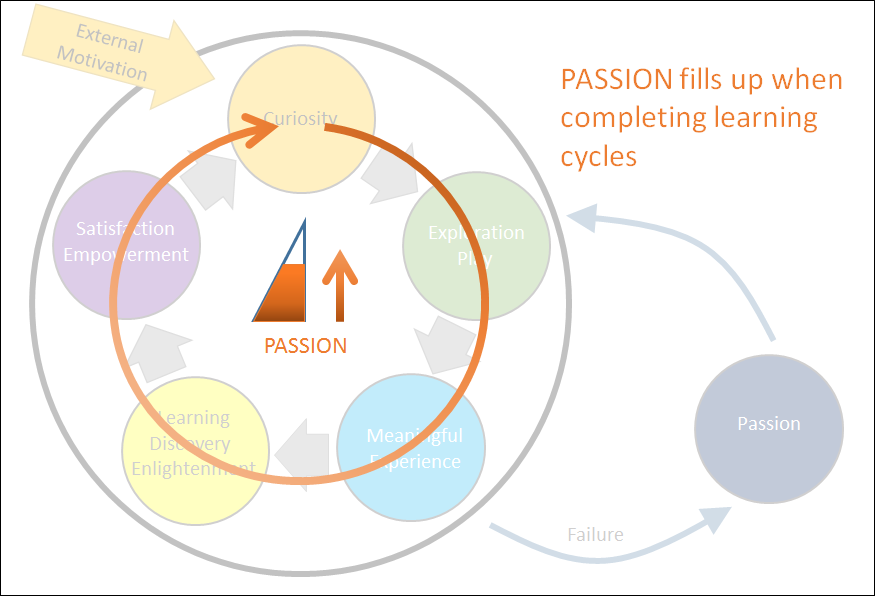
Passion fills up when completing learning cycles
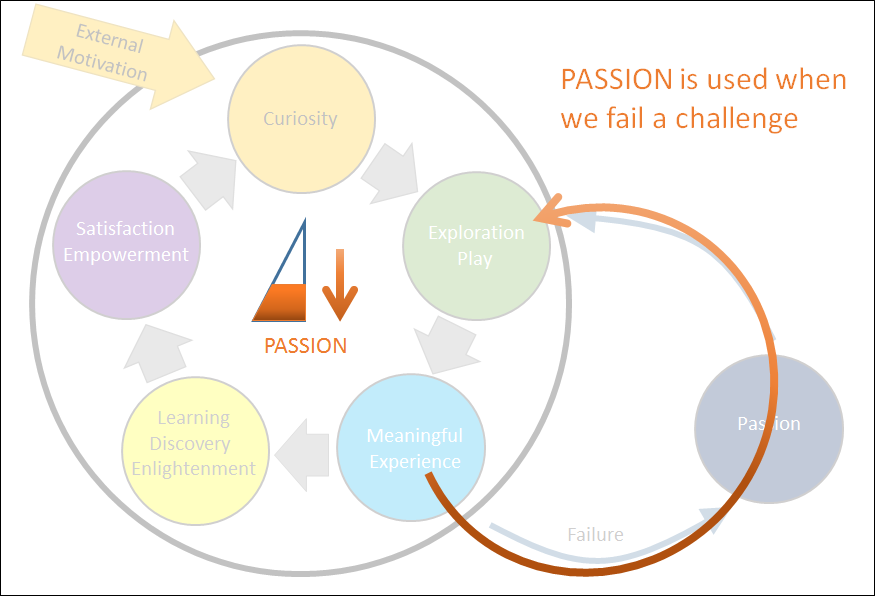
Passion is used when we fail
Passion has an important role to lift us up when we fail a challenge. Say we can't find answers to our questions and we feel that we tried everything we know. We are disappointed of ourselves. To give it another try, or to ask for help, requires us to "consume" some of the passion we accumulated earlier. If we lack of passion resources, we will abandon the learning process for that session. An external source of curiosity (or extrinsic motivation) should be used to get us back into the cycle.
Challenge and Boredom
One might claim that if challenges can fail us, why would we do them at all? Well, without a challenge we simply get bored. Without a challenge, learning cycles would happen very fast, and therefore the satisfaction amounts would be too low, granting little amounts of passion to continue the activity. When no significant new knowledge acquired, no intrinsic curiosity can be triggered.
James Paul Gee, Arizona University Professor for Literacy studies, said that "Good video games build into their design great learning principles". He researched in depth the design principles behind video game design, and how they related to instructional design principles [5]. We have also talked greatly about the similarity between the two areas, coming from our experience in game design [6]. The basic principle of the Flow Theory is that in order to reach the state of Flow the user should be challenged just a little above their skill level, as long as they believe in their ability to overcome that challenge [7]. Research shows the importance of challenging the learner in order to reach effectiveness.
Also note that not all challenges can be prevented. Some of the challenges we encounter are with the medium itself, like in the example we mentioned earlier with the game's interface. This is something that any player would have to go through and learn. Some challenges are not controlled by the teacher. Learning is very personalized, and so are the challenges each student might face. As teachers, we need to make sure they overcome, but doing so, we need to see that they feel it was their victory.
Lecture as a teaching method doesn't challenge the learner. Nor does book reading, or copying a specific letter 100 times. Instead, we need to find what might trigger the learner to look for answers themselves, using our help and guidance.
[5] Gee J.P. (2003). What Video Games Have to Teach Us About Learning and Literacy. Palgrave Macmillan.
[6] Oz, S. (2012). Similarities between instructional design and game design. In Y. Yair, & E. Shmueli (eds.), The world of open information: teleprocessing teaching in the higher education (Pp. 79-80). Rehovot: Weizmann institute of science.
[7] Csíkszentmihályi, M. (1996). Finding Flow: The Psychology of Engagement With Everyday Life. Basic Books.
[7] Csíkszentmihályi, M. (2004). Flow, the secret to happiness. TED talk.
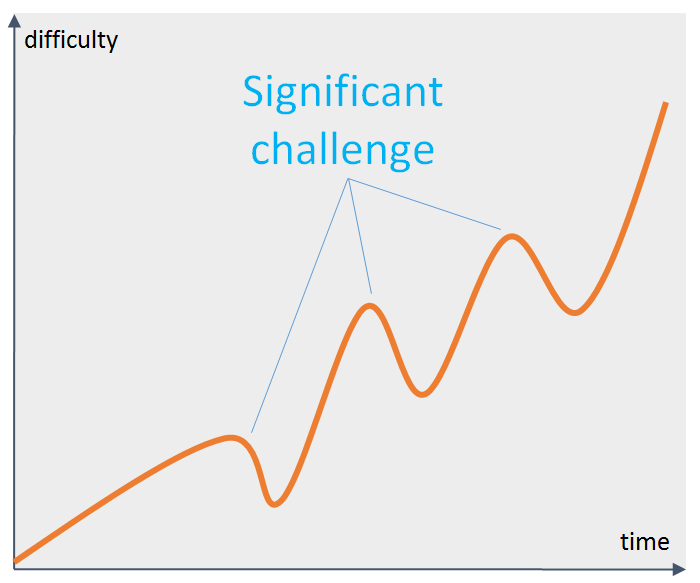
"After succeeding a significant challenge, good games provide much easier ones in order to secure the perceived feeling of achievement" Oz, S. (2012)
Closure: Are Teachers Needed?
Talking about using technology and games in education, we are often asked about the role of the teacher in the era of computing and online learning. With such advancements in technology, will the teacher be excluded from the learning process? Especially when we can find an online free courseware created by the best professors worldwide.
Well, we do not believe this is the case and this article tries to explain that point. The interpersonal bondage between the teacher and their students is crucial to understand their personality, emotional needs, preferences, triggers, intelligences, and passions. No technology exists today can do all that, and we are not sure if it could ever reach human-like emotional understanding.
Teachers are required to change their ways, and become bridges between learner and the knowledge. They need to offer methods of finding answers, rather than providing it themselves. They should be experts in designing several courses of actions to learn a specific topic, using the great materials out there. The educational technology market today is so big that you do not even know where to start. It is much like entering a TARGET store trying to find pants. We need to help our students be able to discover answers by themselves, to questions they have raised. We need to help them to overcome fears, collaborate in teams, work independently, present ideas and concepts, and be caring and aware of each other's needs. The Federation of American Scientists conducted a very extensive investigation on the skills for the 21st century, both for the student and the teacher [8].
There are a lot of examples to teachers already working by this manner with their class. Among our favorites are: Walter Levin, MIT Professor of Physics, with his famous "The Last Lecture" [9]; John Hunter, veteran teacher, with his World Peace game [10]; Quest 2 Learn school and the Blue School at New York.
Great minds have helped us pave our way here: Ken Robinson, Sugata Mitra, Henry Jenkins, Kurt Squire, Jane McGonigal – just to name a few. Our task now is to train teachers to change their mindset, to the one described. Because at some point, the students will just stop coming into class...
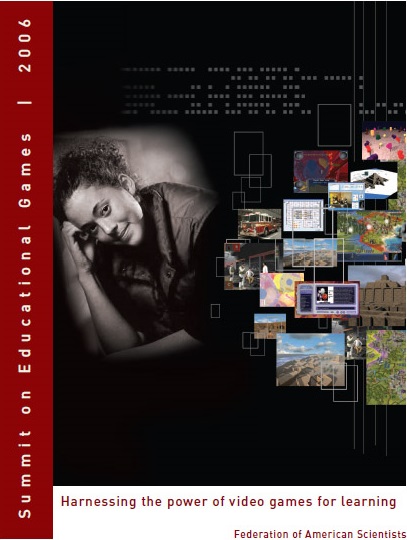
[8] Federation of American Scientists (2006). Harnessing the Power of Video Games for Learning. In Summit on Educational Games 2005. Washington, DC.
[9] Levin W. (2011). For the Love of Physics: The Last Lecture. Boston: MIT.
[10] Hunter J. (2011). Teaching with the World Peace Game. In TED 2011.
Written by Liron Levi and Shachar Oz, 2017
Levi L. & Oz S. (2017). The Learning Cycle: Model Explained. Retrieved [date], from https://www.flux-experiences.com/learning-cycle.html